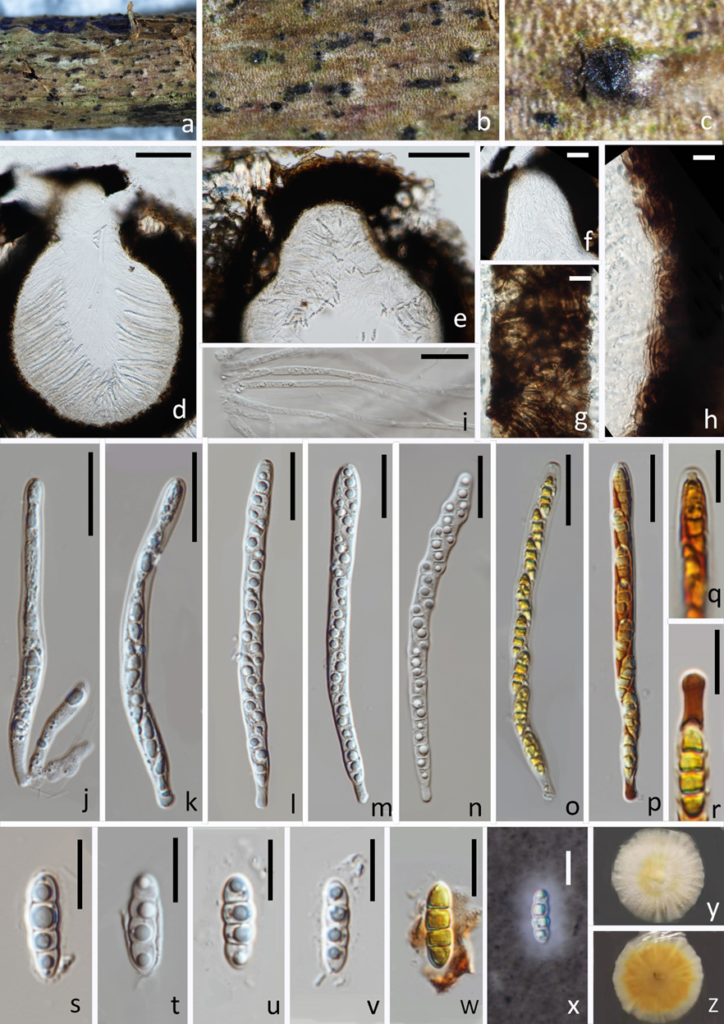Melomastia sichuanensis W.L. Li, Maharachch. & Jian K. Liu, sp. nov
MycoBank number: MB 841501; Index Fungorum number: IF 841501; Facesoffungi number: FoF 10535;
Etymology: Refers to the place where the type species was collected
Holotype: HKAS 121313
Saprobic on dead branches of Olea europaea. Sexual morph: Ascomata 419.5–506 × 335–577 μm ( = 462.5 × 456 μm, n = 15), only ostioles visible at the surface of host, solitary, gregarious, immersed, globose to subglobose, uniloculate, coriaceous to carbonaceous, dark brown to black, rough-walled, ostioles. Ostioles 90–120 × 85–110 μm ( = 105 × 97.5 μm, n = 15), central, carbonaceous, dark brown to black, papillate, periphyses filling the ostiolar canal. Clypeus black, thick-walled. Peridium 44–85.5 μm ( = 65 μm, n = 15) wide, in two strata, an outer layer of cells of textura intricata composed of host cells interspersed with fungal hyphae, carbonaceous and the inner layer comprising lightly brown cells and thin. Hamathecium composed of numerous, 2.5–3.7 μm ( = 3.1 μm, n = 15) wide, dense, filiform, unbranched, septate, cellular pseudoparaphyses. Asci 101–112.5 × 6.5–7.6 μm ( = 107 × 7 μm, n = 30), 8-spored, bitunicate, cylindrical, apically round, with a small ocular chamber, cylindrical pedicellate 3.5–7 × 3.2–3.8 μm ( = 5.3 × 3.5 μm, n = 30). Ascospores 15–17.5 × 4.7–5.1 μm ( = 16 × 5 μm, n = 30), uniseriate, partial overlapping, broad fusiform with rounded ends, ends acute, hyaline, 3-septate, constricted at the septa, with guttules in each cell, smooth-walled with mucilaginous sheath. Asexual morph: Undetermined.
Culture characteristics. Colonies on MEA reaching 30 mm diam. after 4 weeks at 25 °C. Culture from above, yellowish radiating outwardly, with yellow ring in the middle, medium dense, circular shape, covered with cream mycelium; reverse: brown in the middle with an orange ring, dark yellow radiating outwardly.
Material examined: China, Sichuan Province, Chengdu City, Shuangliu District, Olive Base, 30°33.25′N, 103°99.62′E, at an altitude of 432 m (the foot of mountain), 30 January 2021, W.L. Li, Z.P. Liu, T. Zhang, GL 001 (HKAS 121313, holotype; HUEST 21.0007, isotype), ex-type living culture CGMCC3.20620 = UESTCC 21.0007; ibid., GL 005 (HUEST 21.0008, paratype), living culture, UESTCC 21.0008
GenBank numbers –LSU, SSU, TEF, RPB2
Notes: Phylogenetic analysis results showed that Melomastia sichuanensis formed a moderately supported clade sister to M. clematidis (92% ML BS, 86% MP BS, 1.00 BI). In addition, the comparison of tef1-α sequence data between two species showed 46 nucleotides differences without gaps across the 878 nucleotides (5.24%), but only 1 nucleotide difference across 829 nucleotides of LSU and 2 nucleotides differences across the 766 nucleotides of SSU. Morphologically, M. sichuanensis resembles M. clematidis in having 3-septate ascospore with a thin mucilaginous sheath, but M. sichuanensis can be distinguished from M. clematidis in its shorter asci (101–112.5 μm vs. 115–160 μm). Besides, M. clematidis has ellipsoidal to fusiform ascospores with acute ends, while they are ellipsoidal to ovoid in M. sichuanensis with obtuse ends.

Figure 3. Melomastia sichuanensis (HKAS 121313, holotype). (a–c) Ascomata on the subtrate. (d, e) Vertical section of ascoma. (f) Verticle section of ostiole. (g, h) Peridium. (i) Paraphyses. (j–p) Asci (o, p in Lugol’s lodine). (q) ocular chamber in Lugol’s lodine. (r) pedicel in Lugol’s lodine. (s–w) Ascospora (w in Lugol’s lodine, x in India Ink). (x) Upper view of the colony after 14d. (y) Reverse view of the colony after 14d. Scale bars: d, e = 100 μm, f = 40 μm, g, h, q–x = 10 μm, i–p = 20 μm.
